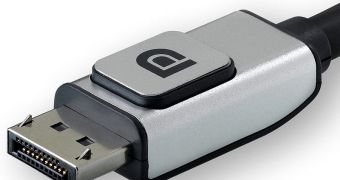In-Stat has published a report in which the market research firm projects that the DisplayPort will see a significant adoption in “mobile Pcs,” according to the company, particularly as an internal interface between the motherboard and the LCD panel.
Put forth by the Video Electronics Standards Association (VESA) since 2006, the DisplayPort is a digital display interface standard adopted by Apple in its recent MacBook and MacBook Pro portable computers. It defines a new, royalty-free, digital audio/video interconnect, intended to be used primarily between a computer and its display monitor, or a computer and a home-theater system.
Besides seeing an increased interest in the DisplayPort standard, In-Stat does add that its implementation across LCD monitors is much less certain, “as LCD manufactures grapple with issues of backwards compatibility.”
“We expect embedded DisplayPort to outpace DisplayPort ports in mobile PCs over the next few years, due primarily to the power reduction advantage,” Brian O’Rourke, In-Stat analyst, says. “Adoption in desktop PCs will be slower because embedded DisplayPort’s power reduction is not as relevant in wired desktops, and external DisplayPort has tough display interface competition. In LCD monitors, DisplayPort enables direct drive monitors, which allows the elimination of the scaler chip and shifts the graphics control to the CPU or GPU in the PC. However, this means the monitors can no longer display VGA, DVI, or HDMI signals without an adapter, creating potential marketing and cost issues for monitor vendors,” the report outlines.
The report outlining how the DisplayPort storms the mobile PC Display Interface market (“DisplayPort 2009: The New VGA or the New DVI?”) includes key findings. For example, In-Stat predicts that shipments of DisplayPort-enabled devices will see a compound annual growth rate of 194% from 2008 to 2013. This is a tremendous growth, according to the analysts, who cite a very low base for 2008.
“2010 will be a very significant year for DisplayPort, as both Intel and AMD are scheduled to release next-generation mobile and desktop PC chipsets and platforms that support it,” In-Stat says, describing another one of its key findings. Competitors listed include AMD, Analogix Semiconductor, Gennum, IDT, Intel, Luxtera, MStar Semiconductor, NVIDIA, Realtek Semiconductor, Texas Instruments, and more.
The research also examines the DisplayPort technology more thoroughly and the applications leveraging it, and also includes forecasts of DisplayPort penetration of mobile and desktop PCs and other product types through 2013. Visit In-Stat here for more information, or to buy the full report.

 14 DAY TRIAL //
14 DAY TRIAL //